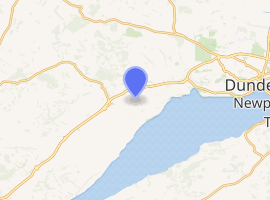HM Prison Castle Huntly
Castle Huntly is a castle in Scotland, now used as a prison under the name HMP Castle Huntly. It is located approximately 7 miles (11 km) west of Dundee in the Carse of Gowrie, Perth and Kinross, close to the shore of the Firth of Tay, and can be seen from the main road linking Dundee and Perth. The castle sits on top of a rocky outcrop surrounded by what is now farmland. In ancient times this land was marshy wilderness and the decision to locate the castle on the rock may have been taken with a view to the castle's defensive position in mind.

| |
| Location | Longforgan, Perth and Kinross |
|---|---|
| Coordinates | 56.4489°N 3.1339°W |
| Status | Operational |
| Security class | Open prison |
| Capacity | 285 |
| Managed by | Scottish Prison Service |
| Governor | Gary Law |
History
Castle Huntly was built around 1452 by Lord Gray of Fowlis under licence from James II of Scotland. The castle changed hands in 1614 when it was acquired by the then Earl of Strathmore who changed its name to Castle Lyon. In the 1770s, the castle was sold by the widow of the 7th Earl of Strathmore to George Paterson of the East India Company who also changed the name back to Castle Huntly. The castle left the hands of the Paterson family in 1946 after the death of Colonel Adrian Gordon Paterson when his wife sold the castle to the government. In 1947, the castle was refurbished and became a borstal, then a young offenders' institution before becoming an open prison for adult male prisoners. It is now known as HMP Castle Huntly and is the only open prison in Scotland. Most prisoners at the establishment are low risk ones serving short sentences of up to two years although some are long sentence prisoners approaching the end of their sentences.
The White Lady and other stories
The castle is said to be haunted by a White Lady, a young woman dressed in flowing white robes. There are various stories concerning her history, one of which is that she was a daughter of the Lyon family who occupied the castle in the 17th century. She allegedly began an affair with a manservant at the castle, and when their relationship was discovered, was banished to a bedroom high up in the tower overlooking the battlements. Unable to endure her suffering, she threw herself (or was she pushed?) to her death from the tower. The ghost of the White Lady has been seen a number of times over the years, often in the grounds surrounding the castle at night. She has also been seen in the bedroom in which she was imprisoned. The families that claim to have seen her report that she does not seem to cause fear and appears harmless.
A second ghost who is claimed to haunt the castle is that of a young boy dressed in a double-breasted sailing jacket. He has been seen in the room from which the White Lady is said to have jumped and there is speculation that he may be the son of Colonel Adrian Gordon Paterson. The Colonel's only son Richard drowned in 1939 in a yachting accident on the River Tay.
References
- Scottish Hauntings, Grant Campbell, Piccolo
